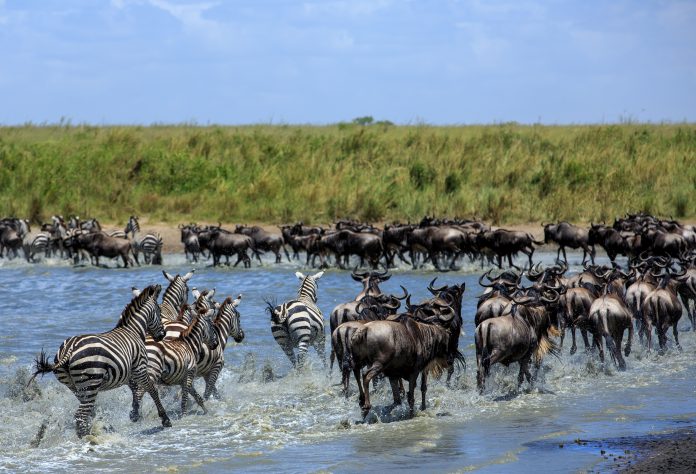In Kenya, wildlife numbers declined by 68% in the 40-year period from 1977 to 2016 both outside and inside protected areas, writes Dr. Joseph Ogutu, Senior Statistician at the University of Hohenheim
Wildlife numbers are declining sharply across Africa, including migratory populations. In Kenya, wildlife numbers declined by 68% in the 40-year period from 1977 to 2016 both outside and inside protected areas.
Most wildlife still occurs on private and communal lands outside protected areas, which cover only 10% of Kenya’s land surface. As with other parts of Africa, protected areas are too small to meet all the needs of their wildlife populations all year in East Africa. Many wildlife species, therefore, spend part or all of the year outside protected areas.
To understand the status of and threats to wildlife migrations in East Africa, we recently reviewed the extent of historical wildebeest migrations and analysed trends in numbers of five migratory wildebeest populations. This understanding can also shed light on the other wildlife species that migrate with wildebeest in East Africa, namely zebra and Thomson’s gazelle. We quantified changes in numbers of the five remaining populations of migratory wildebeest in East Africa using aerial survey monitoring data collected from 1957 to 2016 in Kenya and Tanzania.
The five populations occur in the following five ecosystems within which wildebeest still migrate in East Africa. (1) Greater Serengeti-Mara and (2) Greater Amboseli, both of which straddle the international boundary between Kenya and Tanzania. (3) Athi-Kaputiei near Nairobi in central Kenya. (4) Mara-Loita in south-western Kenya. (5) Tarangire-Manyara in Northern Tanzania.
The ecosystems cover areas that range in size from 40,000 km2 for Serengeti-Mara, 7,730 km2 for Amboseli, 7,500 km2 for Mara-Loita, 2,200 km2 for Athi-Kaputiei to 35,000 km2 for Tarangire-Manyara plus its adjoining lands accessible to wildlife.
Extreme declines in migratory wildebeest populations in East Africa
Except for the Serengeti-Mara population, migratory wildebeest numbers declined extremely in Kenya and Tanzania during the 60-year period from 1957 to 2016.
The Serengeti-Mara population initially increased from 190,000 animals in 1957 to 1.3 million animals in 1977 and fluctuated about this number until 2016.
The Mara-Loita population crashed by 81% from over 123,000 animals in 1977 to under 20,000 animals in 2016.
Similarly, the number of wildebeest migrating from the Serengeti to the Masai Mara reduced by 73% from 588,000 animals in 1979 to 157,000 in 2016.
The Athi-Kaputiei population fell by 95% from 27,000 animals in 1977 to less than 3,000 in 2014.
The Amboseli population declined by 85% from 16,300 animals in 1977 to under 2,400 in 2014.
The Tarangire-Manyara population initially increased from 24,400 animals in 1987 to 48,800 in 1990 and then decreased by 72% to 13,600 animals in 2016.
As a result, four of the five contemporary migrations in East Africa are severely threatened and have virtually collapsed. Far fewer wildebeest take part in the four migrations today than used to a few decades ago. The Athi-Kaputiei, Amboseli and Mara-Loita migrations are the most severely threatened.
Leading threats to wildlife migrations in East Africa
Human population increase and activities are the leading causes of the decrease in numbers of migratory wildlife and collapse of wildlife migrations in East Africa.
The disturbing loss of wildebeest and the virtual collapse of their migrations are caused by several processes that vary in their importance and intensity across the five populations. The major processes are the unplanned expansion of agriculture, fences, settlements, urban centres, roads and other infrastructures, poaching and competition with livestock for food, space and drinking water. These processes are driven, in turn, by increasing human and livestock numbers, changing land tenure and land subdivision.
Additional key drivers are the failure of settlement policies, wildlife conservation and management policies, wildlife management institutions and wildlife markets.
The virtual collapse of four of the five remaining wildebeest migrations increases the risk of local extinctions of wildebeest in the four premier East African Ecosystems.
What can be done to save wildlife migrations in East Africa?
Urgent action is required to save these migrations. Unfortunately, such warnings are too often ignored.
Saving the migrations requires regulating livestock numbers, unplanned expansion of fences, settlements, farms, roads and other land use developments that degrade areas used by migratory wildlife.
Degraded rangelands should also be restored. Fences have blocked most migratory routes for the Athi-Kaputiei wildebeest and are sadly also expanding fast in the Mara-Loita ecosystem.
The obstructions to migrations are increasing at a time when migratory species require greater mobility and flexibility to cope with frequent and intense droughts associated with climate change. These obstructions, therefore, pose grave risks to migratory wildlife and require immediate remedial action. This would allow migratory wildlife species to continue moving over large areas in search of food and water.
Major roads that cut across migratory routes should include under or overpasses for migrating wildlife.
Robust law enforcement is required to reduce illegal hunting for bushmeat.
Wildlife conservancies formed by private landowners or landholders are expanding conservation outside protected areas and protecting migratory pathways while providing land rents and jobs to local communities. More support is needed to plan, expand and manage these conservancies. The success of the common conservancy model depends on sustainable wildlife tourism making it worthwhile for landowners to allow conservancies to be set up on their lands. Because such conservancy models can only be viable where tourism potential is high, other models should be explored for areas with low tourism potential.
Wildlife benefits to local communities should be enhanced to enlist greater local community support for conservation and reduce incentives for poaching and habitat degradation.
Land purchases or permanent conservation easements should be considered to keep land open for wildlife. Temporary conservation land leases for wildlife are likely to be too expensive to be sustainable over large areas and also because the value of land appreciates over time.
Coherent policies that cut across bureaucratic lines on settlements, land use developments, tenure and subdivision, wildlife conservation, management and markets are required to make land use compatible with conservation in perpetuity. Similarly, institutions that conserve and manage wildlife should be restructured, strengthened and better funded to better protect wildlife outside protected areas.
Greater coordination and collaboration are needed between Kenya and Tanzania to conserve the trans-boundary migrations.
Because some of the changes in the five ecosystems are so dramatic and fast, urgent action is required to save the very few remaining migrating animals. Otherwise, some of the migratory populations may soon be lost for good. This has happened to migrations of zebra and Thomson’s gazelle in Kenya’s Rift Valley and elephants across Kenya.
Every effort should be made by all to prevent a similar fate from befalling the remaining migrations in East Africa.
Dr. Joseph O Ogutu was supported by Grants from the German Research Foundation (DFG, Grant #OG83/1-1) and the European Union’s Horizon 2020 research and innovation programme under grant agreement No.641918 through the AfricanBioservices Project.
Dr. Joseph Ogutu
Senior Statistician
University of Hohenheim
Biostatistics Unit, Institute of Crop Science, University of Hohenheim, Fruwirthstrasse 23, 70599 Stuttgart, Germany
Tel: +49 711 459 230 22
jogutu2007@gmail.com
*Please note: This is a commercial profile











